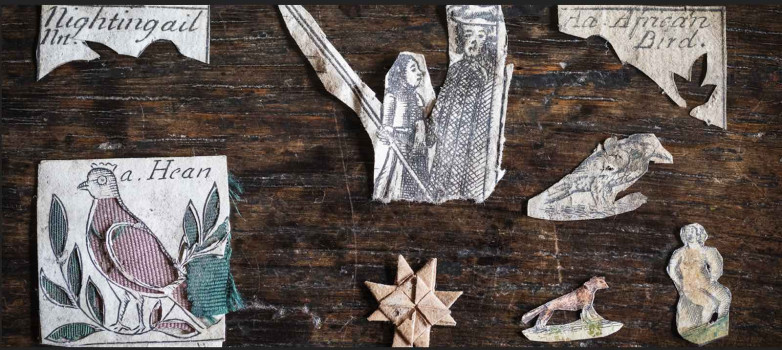Rare Survivals of Decorative Paper Cutting by 17th century Schoolgirls Found Under Floorboards

Paper cuttings at Sutton House
Sutton House, a 500-year-old property in London's Hackney owned by the National Trust, was built for one of Henry VIII’s statesmen and over its lifetime it was home to different families and used for different purposes including a girls’ school in the 17th century.
During renovation of the house by the National Trust from the late 1980s, hundreds of pieces of ephemera that had been found under floorboards were carefully stored away. These finds went uncatalogued for over 30 years until last year, when a team of volunteers began to sort through bags of centuries-old builders’ rubble, discarded textiles, paper and bones and other objects which had been lost over time.
Among the finds was a small number of cut-out paper designs, only a few centimetres in size, some hand coloured. Eight of these have been dated to the late 17th century when papercutting as a pastime in the UK was in its infancy and are extremely rare survivals. Dating from the time when Sutton House was a school for girls, the paper discoveries include an intricate folded paper star, hand-coloured cut-outs of a fox, and a female figure bathing, and a hen with added green and pink silk embellishment, along with black and white cut-outs of a bird and a country couple in clothing of the period.
The cutting out of prints in the 17th century was an art form usually undertaken by girls or women and a skill that they could use to showcase their taste and dexterity. Paper folding, as exemplified in the small star identified at Sutton House, was an increasingly popular European fashion especially for elaborate napkin-folding for entertaining. Paper cutting was taught to girls along with other crafts such as embroidery and needlework. Designs from books could be cut out, using tiny pairs of scissors, knives and even pins, and then hand-coloured to use as decoration on boxes and other items.
Due to the ephemeral nature of the art form, only a few examples from this time survive but the practice could well have been the forerunner to the print rooms of the 18th century and decoupage that was popular among Victorians.
Dr Isabella Rosner, an expert in early modern material culture, identified the paper cuttings at Sutton House which are almost identical to only two other known surviving examples, one of which is a decorative box dating to the 1680s held in a collection at Witney Antiques in Oxfordshire.
“Paper cutting for decoration was a subject in various household management books for women in the 17th century," she said, "notably by Hannah Woolley, such as the 1668 A Guide to Ladies and 1674 A Supplement to the Queen-Like Closet. She described the "cutting of Prints, and adorning Rooms or Cabinets, or Stands with them" as skills which "I shall be willing to impart to them, who are desirous to learn".
"In the middle of the 17th century, Hackney was the centre of girls’ education in England, and from 1657 Sutton House was a girls’ school under the lead of Sarah Freeman. It is believed that Hannah Woolley who also established a school in Hackney with her husband may have taught at Sutton House after she was widowed, and so it is possible the paper cut-outs identified were carried out by pre-teen and teenage girls under her tutelage. The prints found underneath the Sutton House floorboards are hugely exciting, as they give us glimpses into the rich material world of middle and upper-class schoolgirls 350 years ago.”
The paper-cuttings will be on display at Sutton House from July 19 through December.















